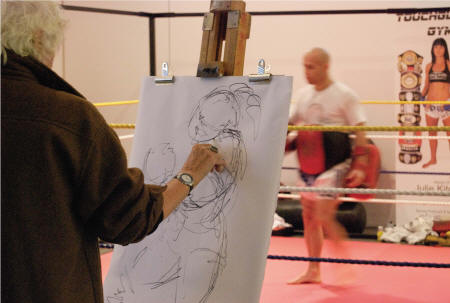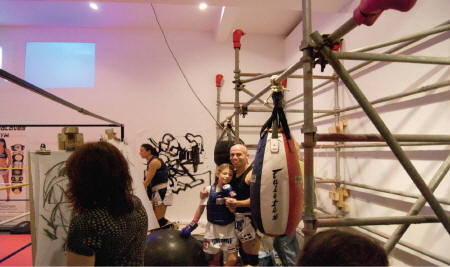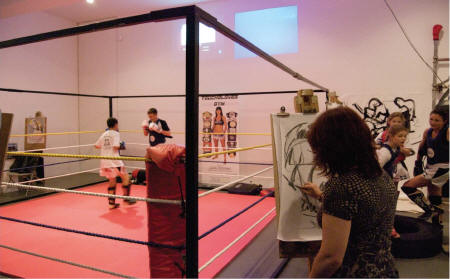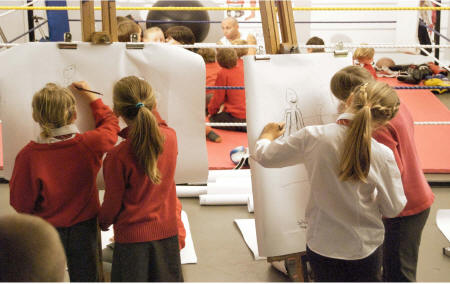|
|
| home | features | exhibitions | interviews | profiles | webprojects | gazetteer | links | archive | forum |
|
|
|
Get in the Ring: Political Aesthetics Rebecca Weeks responds to 'Get in the Ring': a collaborative work, with Ken Turner as lead artist, made for the NSA show 'Double Vision' at The Exchange in Penzance, Cornwall.
In this sense the attitude of the art world can be seen as in league with neo-liberalism which is about paying lip service to the narrative of social justice without any intellectual commitment to it: the production of consensus through silencing disputation and so the reaffirmation of the status quo. This double action of giving with one hand and taking with the other, of inviting in and then pushing people back out, can be seen to be operating at the heart of contemporary visual culture. This attitude leads to work which may not be traditional in its form, but which does nothing in relation to reconfiguring the relationships around the production and consumption of art and contributes nothing towards a greater cultural democracy in the long term. In the prevailing model of outreach, the system is closed; the activities through which people are to engage in are prescribed. People are given an activity to do, an information sheet, they go home and nothing changes. There are not the resources intellectual, or actual to support a real dialogue or a sense of what a real dialogue might result in.
In ‘The Politics of Aesthetics’ Rancière outlines the established way of things as what he calls the “distribution of the sensible”. This distribution delimitates what is possible to see and hear, to say and think, to do and make. The distribution of the sensible represents the conditions of possibility for perception, thought, and activity. Within Rancière’s analysis the sensible is partitioned into various regimes and therefore delimits forms of inclusion and exclusion in a community. This distribution of the sensible provides the context for Rancière’s definition of politics, though not as based around any actual obviously political structure or party; for these forms belong to the police order that attempts to maintain a particular distribution of the sensible. For Rancière politics is the assertion of the universal political axiom: “we are all equal” and this assertion is applied by those outside of the communal distribution of the sensible, those who are not provided for within the police order. Their ongoing disputes attempt to reconfigure the sensible so that they may be heard and understood.
Rancière’s discussion of
‘heterology’ makes me wonder if kickboxing within the gallery might have
operated similarly to offer this kind of disruption through the
simultaneous experience of a readable political signification and a
perceptual shock caused conversely by the uncanny, which resists
signification and so disrupts the possible without having to resort to
an explicit message. The project in this sense could be understood as a
tightrope walk between the apparent message that threatens to destroy
the form of art and the radical aesthetic that threatens to destroy
political meaning. In this sense there are parallels between Rancière’s
understanding of the importance of the simultaneous existence of a
radical aesthetic and its re- ordering impact upon the way of things,
and Walter Benjamin’s discussion of ‘the correct political tendency’
and the ‘literary tendency’ or the political intent of a work and
its form. Benjamin outlines the clear
It is possible to understand the placing of the kickboxing ring within the gallery as the key aspect of the ‘Get In The Ring’ project in relation to the history of radical activist art, but also in relation to an ongoing desire to explore a model for engaging wider audiences which simultaneously explores the critical context for that work in the spirit of the original political drives which gave birth to such practices. In this sense ‘Get In The Ring’ operated as an outreach and inreach project attempting to engage those without and within the art-world in an exploration of how such processes can be meaningful. For me the answer to this fundamental question is fairly simple in this instance. Julie and Nathan, the kickboxers with whom a dialogue has been opened have proposed the next stage of the project takes place at an actual fight and that we enter into the environment of a fight that will be alien to us as the gallery was to them.
Get in the Ring: Political Aesthetics is one of a number of essays, which together with drawings, poems and photographs make up 'Kick to the Head and Heart of Art' a book available through Lulu
|


 WHW
have written in their curatorial essay for the Istanbul Biennial about
the current desire to keep art and politics separate at the same time as
apparently working to enable democracy: “The irony, of course, is
that the art of today is in the service of politics - but politics
cheapened to the production of consensus, that is to the reaffirmation
of the status quo, invariably clad in the garments of ‘democracy”’ (WHW).
WHW
have written in their curatorial essay for the Istanbul Biennial about
the current desire to keep art and politics separate at the same time as
apparently working to enable democracy: “The irony, of course, is
that the art of today is in the service of politics - but politics
cheapened to the production of consensus, that is to the reaffirmation
of the status quo, invariably clad in the garments of ‘democracy”’ (WHW).

